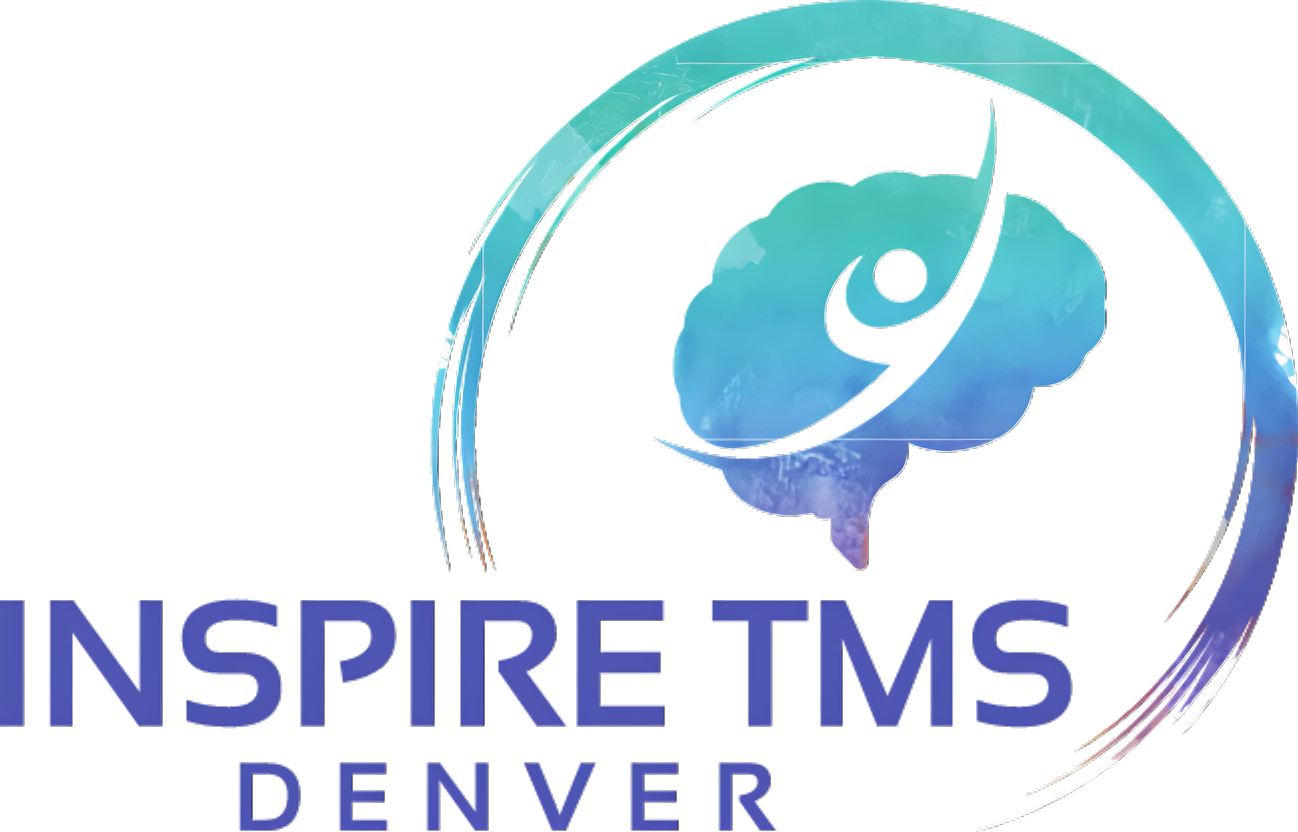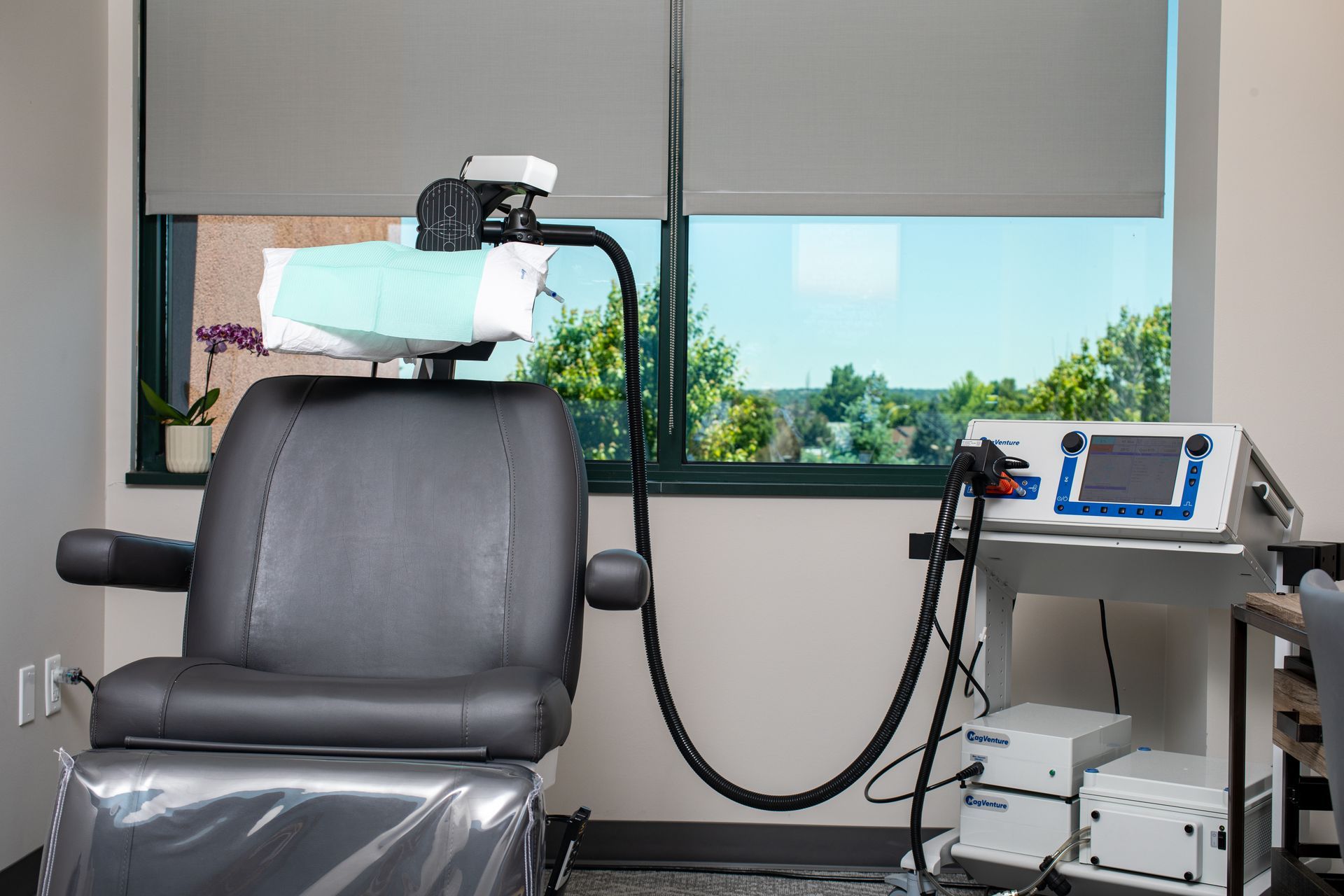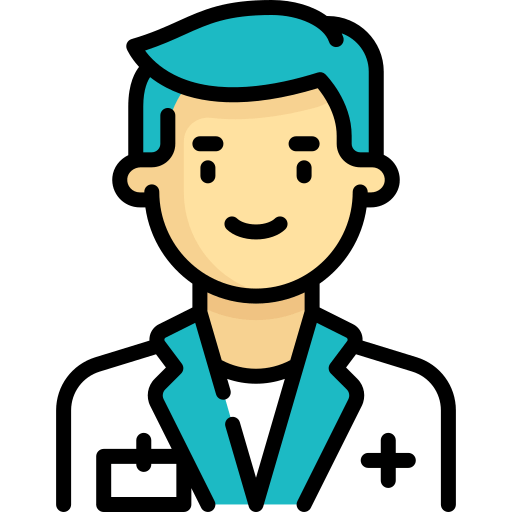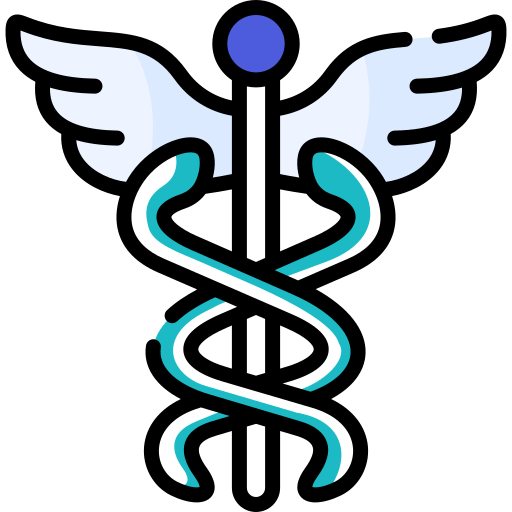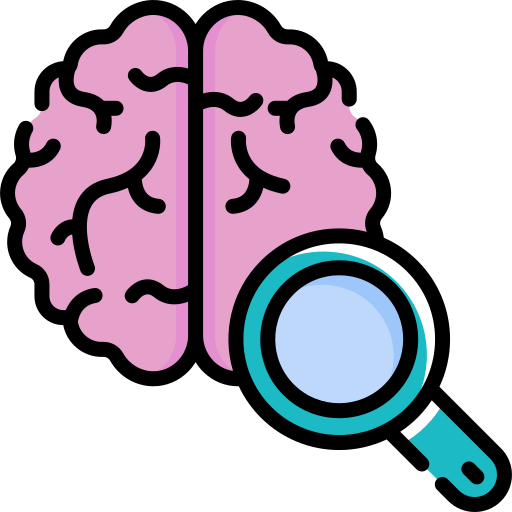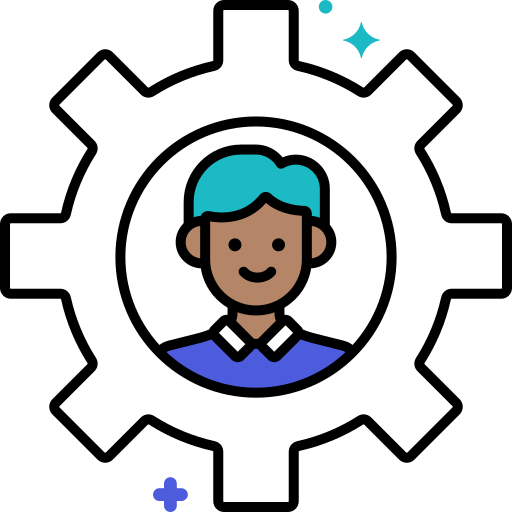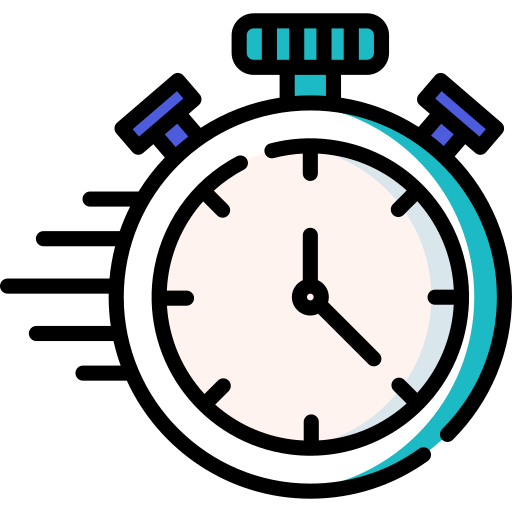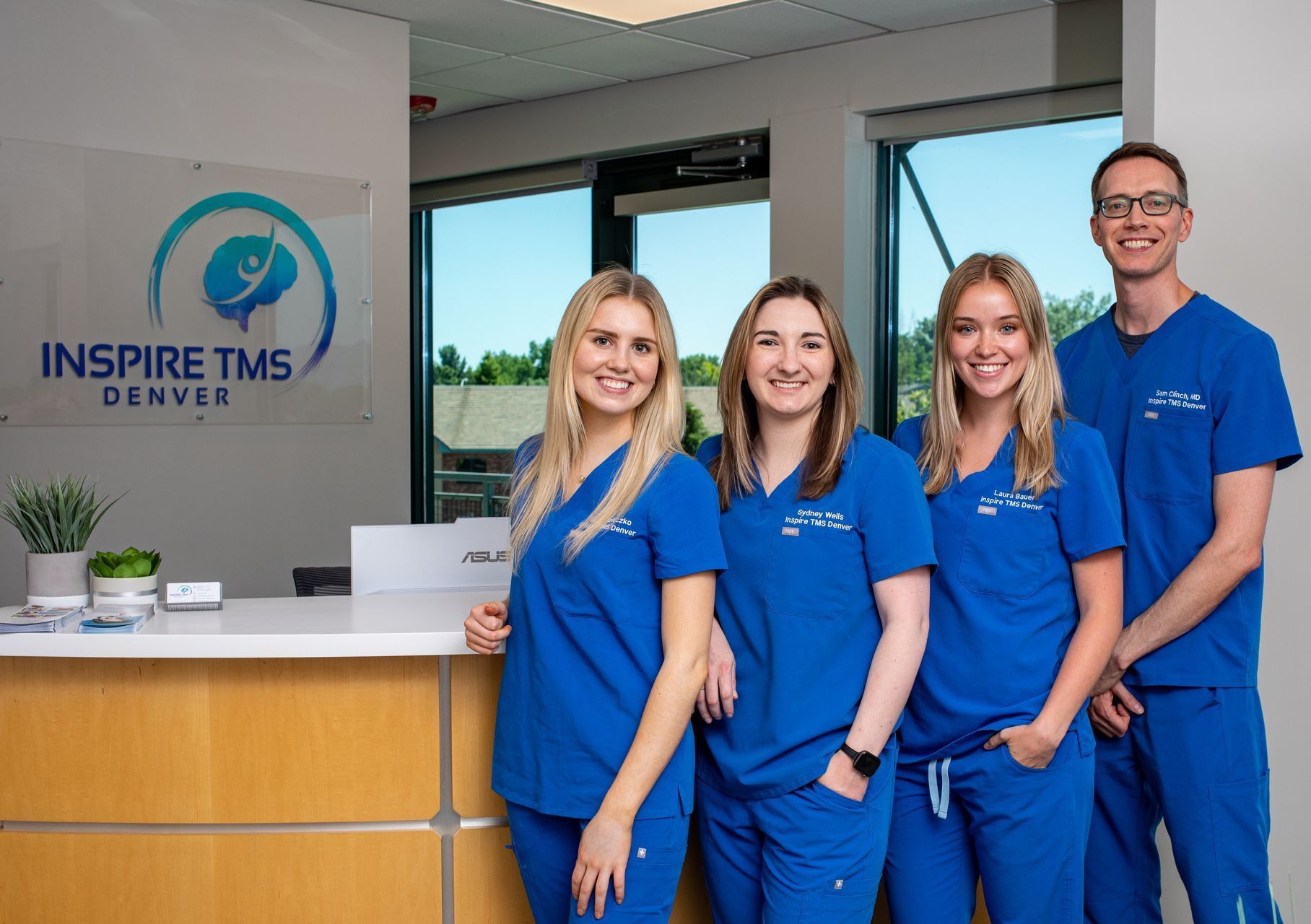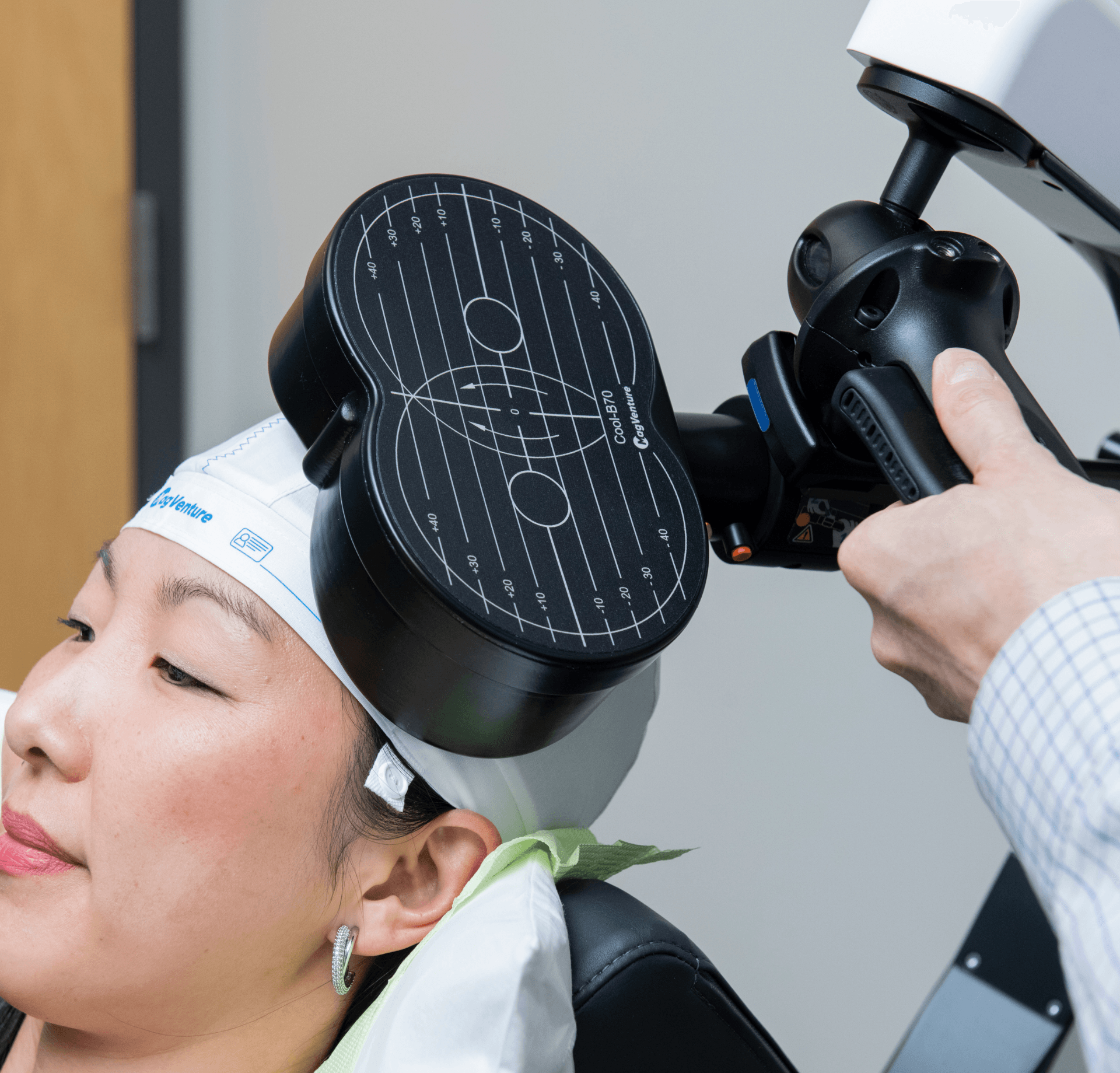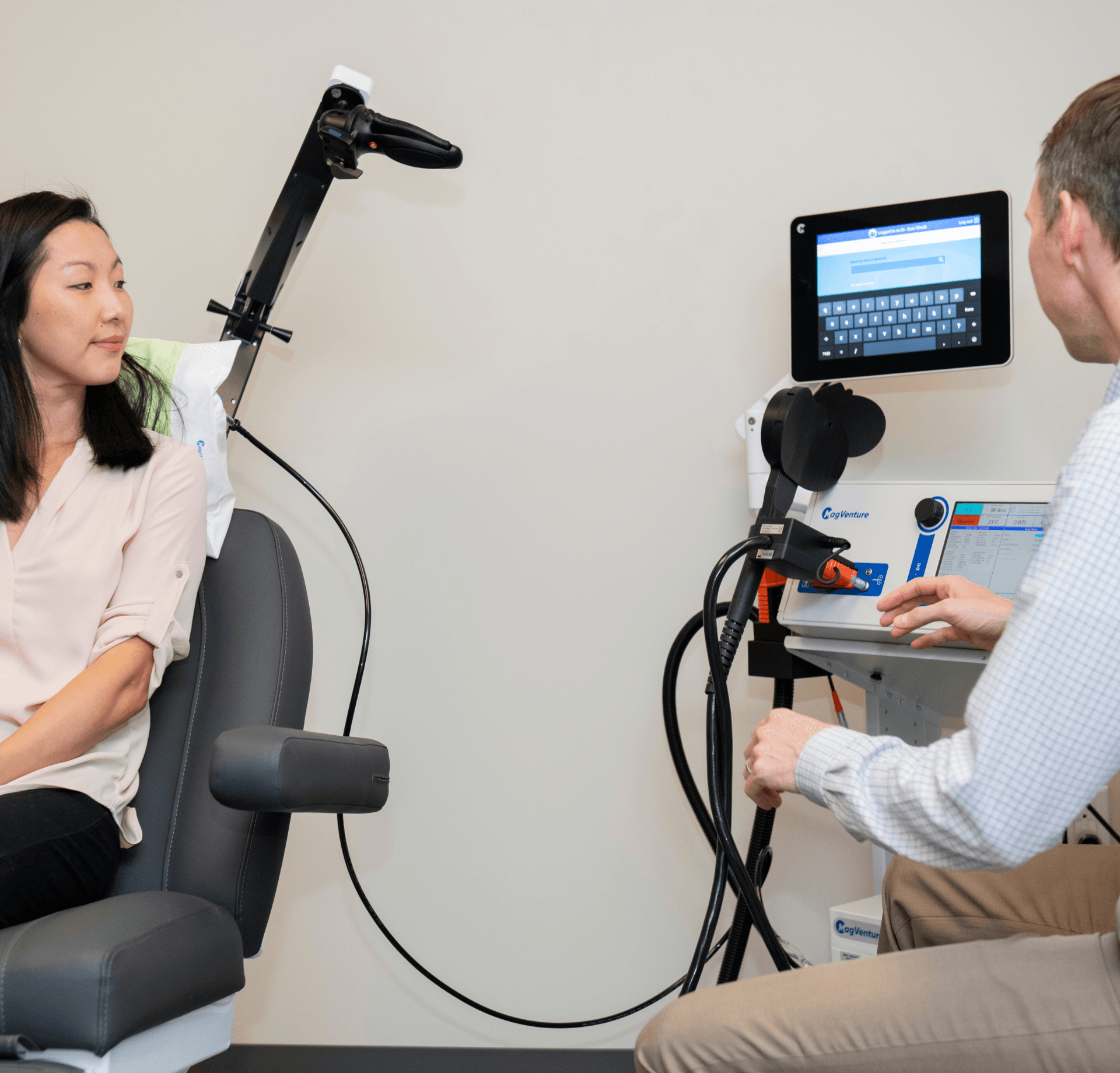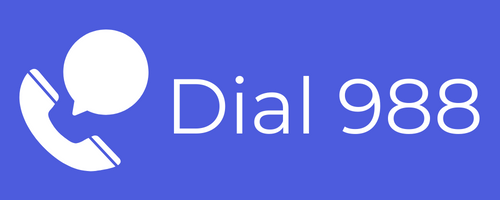With repetition, this becomes more and more embedded into the brains’ default pathways. Therapy such as Cognitive Behavioral Therapy-CBT, or Exposure and Response Prevention Therapy-ERP, work by helping the patient to challenge their mental assumptions and create and reinforce a new narrative. Therapy can actually reform healthier neural pathways to re-establish these as the dominant, default connections.
TMS Therapy For OCD
In OCD, repetitive compulsions or rituals occur to relieve anxious thoughts, but the anxiety keeps coming back. Find out how TMS breaks the cycle.
TMS Therapy for OCD
In OCD, repetitive compulsions or rituals occur to relieve anxious thoughts, but the anxiety keeps coming back. Find out how TMS breaks the cycle.

In OCD, repetitive compulsions or rituals occur to relieve anxious thoughts, but the anxiety keeps coming back. Find out how TMS breaks the cycle.
TMS Therapy For OCD
 Rating
Rating
TMS For Obsessive Compulsive Disorder In Denver
Rediscover your tranquility
Obsessive compulsive disorder-OCD, has entered popular vocabulary to describe someone who has perfectionist tendencies and is very particular about details in one or more areas. Unfortunately, this is misleading and causes confusion about a very real and debilitating mental health condition.
Personality Vs Disorder
Some of us are naturally untidy, disorganized, and scatterbrained, whilst others are characteristically methodical, paying attention to or even micromanaging every detail. It is important to understand that a tendency to be slightly obsessive and compulsive as part of a person's personality is different from Obsessive Compulsive Disorder.
OCD manifests itself in all areas of daily life as a heightened and irrational need to control the environment with repetitive behaviors required to diminish the associated anxiety. People with OCD and related disorders are often very much aware that the fear is irrational but this does not minimize the emotional reaction.
As with all mental disorders, symptoms present in diverse ways and these sit on a spectrum of varied thoughts and behaviors. Some suffer with more obsessions and experience repeated distressing thoughts from this. Others develop more repeated compulsions as anxiety coping strategies that are needed to diminish anxiety or avoid ‘disaster’. OCD is often a vicious circle.
The more these compulsions are repeated, the more established they become within the brains’ neural pathways resulting in repetitive rituals, such as handwashing or skin picking, which reinforce thought processes further and lead to increased obsessiveness. Furthermore, acting out these rituals triggers reward systems in the brain to reinforce the loop.
Living with OCD
These behaviors become all-consuming and are hugely detrimental to functioning in relationships and daily life.
Obsessive compulsive disorder-OCD, and anxiety often can progress to depression. Distressing thoughts about certain fears such as becoming ill or hurting others become the dominant self-narrative. The mind appears to negotiate with these dreadful thoughts in identifying procedures or rituals that will act as protection against these fears becoming real.
The behaviors then become the one thing that keeps the sufferer ‘safe’, in turn leading to more rituals to stay safe and relieve anxiety. The cycle often becomes never-ending. Viewed at a high level, it can be seen that the brain's survival functions have gone into overdrive with no rationalizing influence. These fears can take many forms and sometimes previous traumas inform many of them. Some of the more typical forms of obsessive compulsive disorder present with the following beliefs and symptoms:
OCD Symptoms - Obsessions
OCD Symptoms - Compulsions
Breaking the Cycle of OCD
This cyclical nature is prevalent in OCD, regardless of the nature of the fears or of its manifestation. We see a cycle of -
Anxiety, followed by compulsion or ritual to relieve said anxiety, and the unfortunate eventual resurgence of anxiety.
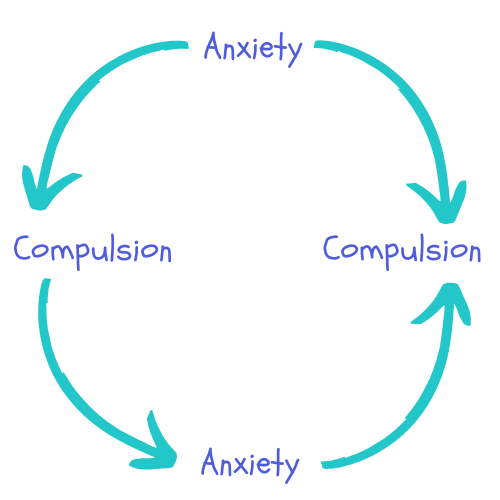
CBT treatment programs rely on the subject’s acceptance and commitment to the regular processes of self-talk and visualization whilst resisting the OCD urges. Because of this, improvement takes time and is often dependent on the patient’s engagement for success. It is usually prescribed with various drugs to provide relief from the exhausting existence of living with OCD.
Deep TMS (dTMS)
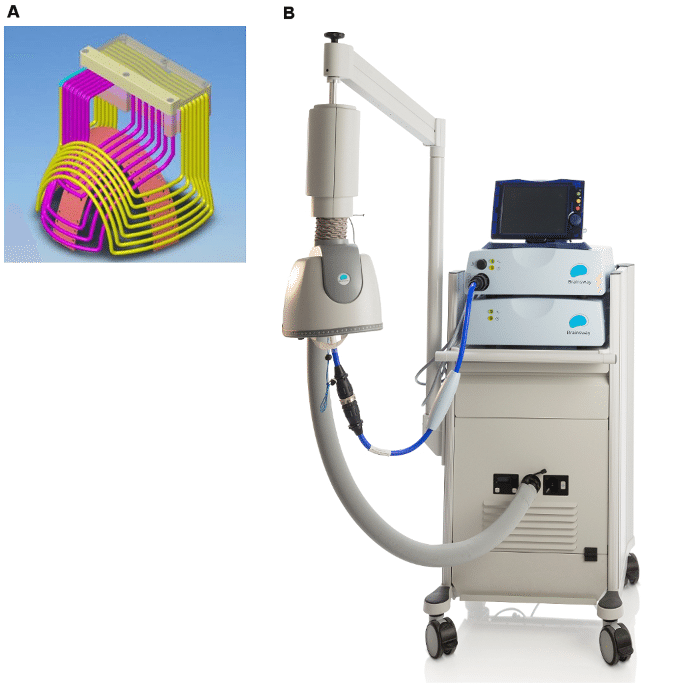
In 2018, a specific type of TMS called ‘deep’ Transcranial Magnetic Stimulation was approved by the FDA specifically to augment treatment for OCD. This was only available through one device manufacturer - Brainsway. In 2020, however, the FDA also approved Magventure’s Cool D-B80 coil for the same indication after Magventure replicated findings in some 500 patients using their coil.¹ This coil likewise has the capability of reaching deeper brain structures needed to reach OCD circuits. Learn more about The Latest Advancements in TMS. Inspire TMS Denver has a Magventure system with capability for providing OCD treatment.
OCD has been a target for TMS treatment for some time even before deep TMS, however. Similar to TMS therapy for Treatment Resistant Major Depression, the approach with TMS is to change dysfunctional communication between neurons in the cortex, or outer shell of the brain, extending to neurons in much deeper brain circuits. There is a complex pathway involved in OCD called the cortico-striato-thalamo-cortical (CSTC) circuit. Directing stimulation to associated areas of the brain along this circuit has the capability of correcting miscommunication and relieving OCD symptoms. In treating Major Depression, the target for stimulation is an area called the DLPFC (dorsolateral prefrontal cortex). Studies directing stimulation at this site have not shown benefit in OCD, however. In light of this, different areas have been stimulated to treat OCD with varied success,² but the latest use of deep TMS targets an area called the dorsal medial prefrontal cortex and the associated bilateral anterior cingulate cortices - DMPFC and ACC.
Read more:
Accelerated TMS Therapy →
A multi-center randomized control trial showed significant difference in response between control and sham treatments with a 38% response for those receiving deep TMS and 11.1% for those receiving a sham treatment. After a 1 month follow-up the response improved to 45% for deep TMS with the sham group also coming up a bit to 18%.³ These patients had a primary diagnosis of OCD with some level of treatment resistance to standard treatment, absence of other clinical diagnoses, and response was determined based on what is called the YBOCS (Yale-Brown Obsessive Compulsive Scale). Similar to Major Depression treatment, some 30% or more of patients with OCD are resistant to standard medication and therapy treatment. In the past, neurosurgery might be the only next step for patients with severe OCD. Deep TMS provides an non-invasive and safe alternative for those with debilitating and repeated obsessions and compulsions.
TMS for OCD vs TMS for Major Depression⁴
There are a number of similarities and differences between these treatments. They are more alike than different, however, as they both employ the same technology and device set-up.
Read more: How does TMS therapy work? →
Similar to TMS for Major Depression, deep TMS for OCD has been shown to be well-tolerated and safe.⁵ The targets are at slightly different locations, but still involve placing the magnetic coil at a specific predetermined area on the scalp just adjacent to the target area. In Major Depression, this is the DLPFC (dorsolateral prefrontal cortex). In OCD, this is the DMPFC (dorsomedial prefrontal cortex).
The stimulation frequency is slightly different in OCD treatment at 20 Hz compared to 10 Hz for Major Depression. This is the frequency that has been utilized in the studies that achieved FDA clearance. Theta burst is yet another frequency that is commonly employed for Major Depression as well. This treatment reduces time in the chair to just three minutes. It has not been well studied yet with this particular OCD treatment.
Read more: Theta Burst Stimulation →
10 Hz treatment for Major Depression and 20 Hz treatment for OCD both take about 19 minutes to complete a treatment. There are a number of other differences in the protocols, such as how the intensity of treatment is calculated, the percent intensity utilized during treatment, and the total pulses delivered for each treatment type.
As noted, the OCD treatment also reaches slightly deeper brain structures and so this can result in slight increase in pain perception or headache. Despite this, however, the OCD treatment remains generally well tolerated and patients usually adjust to treatment, similar to TMS for depression, by using gradual increase in treatment intensity over the first sessions.
Similar to TMS for depression, TMS for OCD utilizes five treatments per week over six weeks = 30 total sessions. After this, a short taper strategy is employed and maintenance treatments may be needed to keep OCD symptoms under control. Comparatively, TMS for Major Depression treatment may be more likely to remain in remission following stoppage of TMS treatment for a longer time period.
Another key difference with OCD treatment, is that patients must have the OCD pathway ‘provocated’ prior to stimulation. Essentially, the OCD symptoms must be activated. This is done by discussing or activating the OCD thoughts in some way for several minutes prior to treatment and encouraging the patient to think about their OCD during the treatment.
Deep TMS for OCD was only FDA approved in 2018 and it often takes several years before insurers begin to cover treatment. In light of this, OCD treatment is not always covered through insurance at this time. Inspire TMS Denver can help to determine this and provides competitive rates for self-pay.
More questions about TMS Therapy for OCD or other information on this page? Contact us here to see about a free phone consultation.
Free Consultation
What Happens After I Send My Message?
- A member of our team will confirm your free consultation appointment within one business day.
- Discover if TMS is right for you and answer all your queries about treatment, eligibility and costs.
Contact Us
We will get back to you as soon as possible.
Please try again later.


Slide title
Write your caption hereButton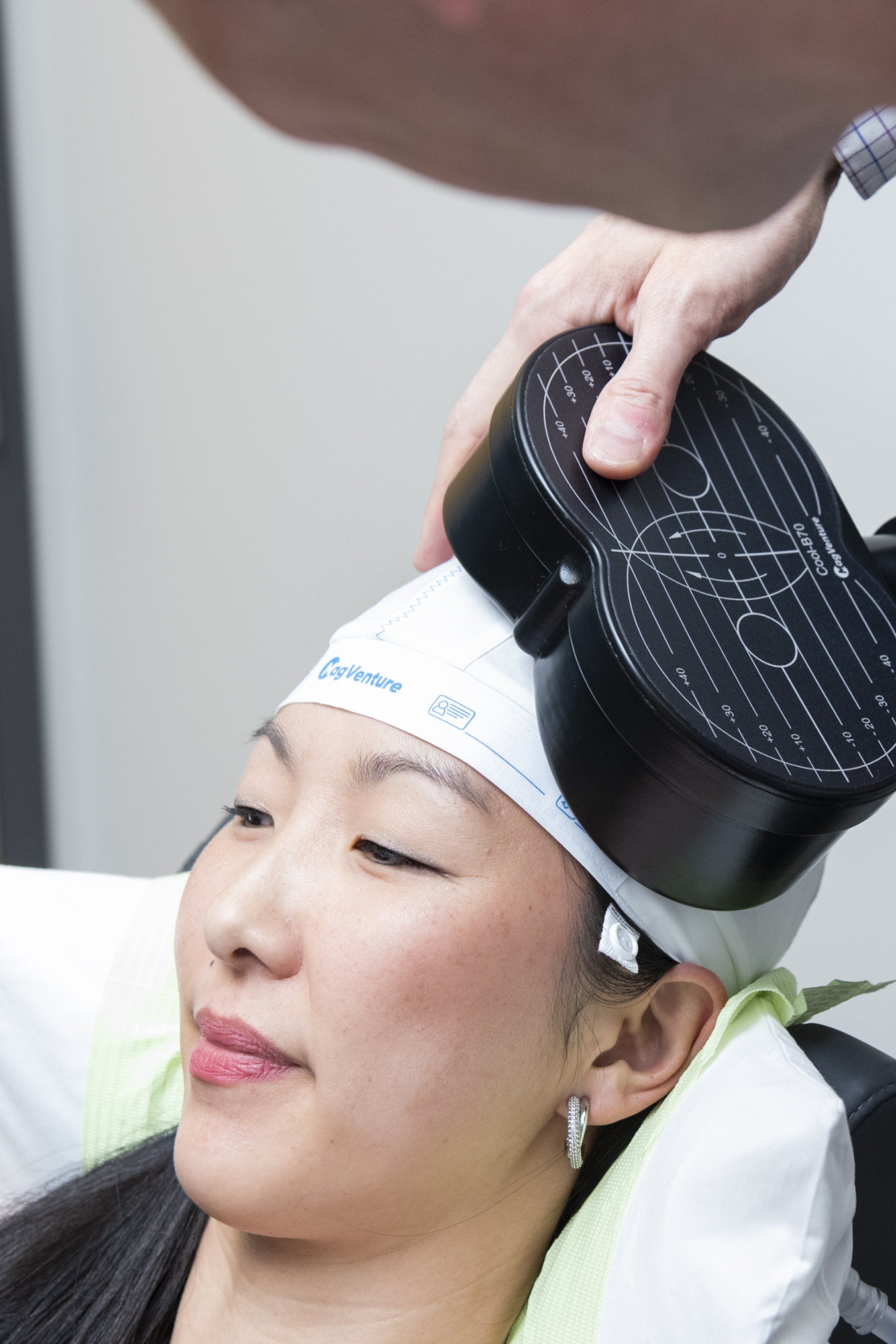
Slide title
Write your caption hereButton
Slide title
Write your caption hereButton
What Makes Us Different
Free TMS Therapy Guides, Quizzes & Phone Consultations


As Seen On Colorado's Best
For more visit our video library →
Awards & Accreditations
This is a paragraph. Writing in paragraphs lets visitors find what they are looking for quickly and easily.
This is a paragraph. Writing in paragraphs lets visitors find what they are looking for quickly and easily.
This is a paragraph. Writing in paragraphs lets visitors find what they are looking for quickly and easily.
This is a paragraph. Writing in paragraphs lets visitors find what they are looking for quickly and easily.
This is a paragraph. Writing in paragraphs lets visitors find what they are looking for quickly and easily.
Company Name
the tms journey
A Step By Step Process

Book your free telephone consultation with Dr. Clinch and use this time to ask any questions or voice any concerns about TMS. If there are no contraindications to treatment, you are a good candidate, and you wish to proceed with a full evaluation, we will schedule a full intake. You will be sent an invite to our confidential patient portal and forms for review and completion that expedite care.
Shortly after this, you will be seen in person for the full TMS evaluation. This will provide adequate information for us to then submit prior authorization for TMS coverage to your insurer. If seeking care off-label through self-pay, prior authorization is not needed. We then schedule your first and all subsequent treatment sessions. We obtain prior authorization and inform you of all costs prior to starting care.
Come in for your first treatment which starts with a 'mapping' to establish your unique treatment intensity and location. Following this and at all subsequent sessions, you will recline in a motorized chair, similar to a dental visit. You can then relax, listen to music, watch TV, read or chat during the treatment. At the end of your sessions, you can drive and return to your day as normal.
Samuel B. Clinch, M.D
Medical Director
Our shared inspiration is to alleviate mental illness and improve the mental wellbeing of the patients we treat. We respect all backgrounds and cultures and want to hear our patient’s stories to best guide care. During treatment, we reinforce positive wellness practices, help maximize lifestyle modifications, and integrate rTMS therapy into a patient’s overall mental and physical health treatment.
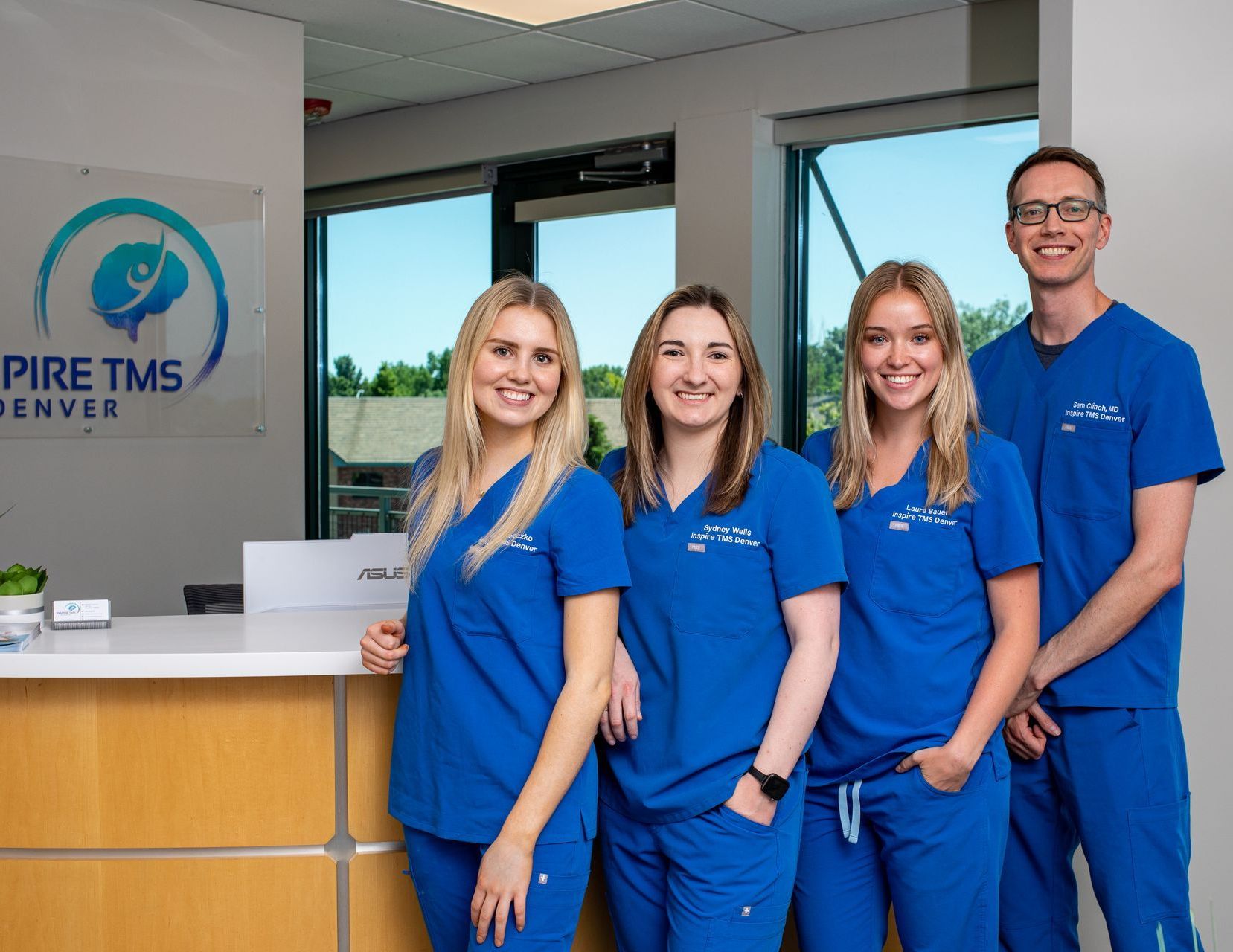

Free Consultation
Call 720-446-8675 now, or complete the form below to request a call back.
Contact Us
We will get back to you as soon as possible.
Please try again later.
Contact Us
LOCATION
340 East 1st Avenue, Suite 333
Broomfield, CO 80020
What Happens After I Send My Message?
A member of our team will confirm your free consultation appointment within one business day.
Discover if TMS is right for you and answer all your queries about treatment, eligibility and costs.
Take the First Step Towards Your Mental Well-being Today
TMS For Obsessive Compulsive Disorder In Denver
Rediscover your tranquility
Obsessive compulsive disorder-OCD, has entered popular vocabulary to describe someone who has perfectionist tendencies and is very particular about details in one or more areas. Unfortunately, this is misleading and causes confusion about a very real and debilitating mental health condition.
Personality Vs Disorder
Some of us are naturally untidy, disorganized, and scatterbrained, whilst others are characteristically methodical, paying attention to or even micromanaging every detail. It is important to understand that a tendency to be slightly obsessive and compulsive as part of a person's personality is different from Obsessive Compulsive Disorder.
OCD manifests itself in all areas of daily life as a heightened and irrational need to control the environment with repetitive behaviors required to diminish the associated anxiety. People with OCD and related disorders are often very much aware that the fear is irrational but this does not minimize the emotional reaction.
As with all mental disorders, symptoms present in diverse ways and these sit on a spectrum of varied thoughts and behaviors. Some suffer with more obsessions and experience repeated distressing thoughts from this. Others develop more repeated compulsions as anxiety coping strategies that are needed to diminish anxiety or avoid ‘disaster’. OCD is often a vicious circle.
The more these compulsions are repeated, the more established they become within the brains’ neural pathways resulting in repetitive rituals, such as handwashing or skin picking, which reinforce thought processes further and lead to increased obsessiveness. Furthermore, acting out these rituals triggers reward systems in the brain to reinforce the loop.
Living with OCD
These behaviors become all-consuming and are hugely detrimental to functioning in relationships and daily life.
Obsessive compulsive disorder-OCD, and anxiety often can progress to depression. Distressing thoughts about certain fears such as becoming ill or hurting others become the dominant self-narrative. The mind appears to negotiate with these dreadful thoughts in identifying procedures or rituals that will act as protection against these fears becoming real.
The behaviors then become the one thing that keeps the sufferer ‘safe’, in turn leading to more rituals to stay safe and relieve anxiety. The cycle often becomes never-ending. Viewed at a high level, it can be seen that the brain's survival functions have gone into overdrive with no rationalizing influence. These fears can take many forms and sometimes previous traumas inform many of them. Some of the more typical forms of obsessive compulsive disorder present with the following beliefs and symptoms:
OCD Symptoms - Obsessions
OCD Symptoms - Compulsions
Breaking the Cycle of OCD
This cyclical nature is prevalent in OCD, regardless of the nature of the fears or of its manifestation. We see a cycle of -
Anxiety, followed by compulsion or ritual to relieve said anxiety, and the unfortunate eventual resurgence of anxiety.

With repetition, this becomes more and more embedded into the brains’ default pathways. Therapy such as Cognitive Behavioral Therapy-CBT, or Exposure and Response Prevention Therapy-ERP, work by helping the patient to challenge their mental assumptions and create and reinforce a new narrative. Therapy can actually reform healthier neural pathways to re-establish these as the dominant, default connections.
CBT treatment programs rely on the subject’s acceptance and commitment to the regular processes of self-talk and visualization whilst resisting the OCD urges. Because of this, improvement takes time and is often dependent on the patient’s engagement for success. It is usually prescribed with various drugs to provide relief from the exhausting existence of living with OCD.
Deep TMS (dTMS)

In 2018, a specific type of TMS called ‘deep’ Transcranial Magnetic Stimulation was approved by the FDA specifically to augment treatment for OCD. This was only available through one device manufacturer - Brainsway. In 2020, however, the FDA also approved Magventure’s Cool D-B80 coil for the same indication after Magventure replicated findings in some 500 patients using their coil.¹ This coil likewise has the capability of reaching deeper brain structures needed to reach OCD circuits. Learn more about The Latest Advancements in TMS. Inspire TMS Denver has a Magventure system with capability for providing OCD treatment.
OCD has been a target for TMS treatment for some time even before deep TMS, however. Similar to TMS therapy for Treatment Resistant Major Depression, the approach with TMS is to change dysfunctional communication between neurons in the cortex, or outer shell of the brain, extending to neurons in much deeper brain circuits. There is a complex pathway involved in OCD called the cortico-striato-thalamo-cortical (CSTC) circuit. Directing stimulation to associated areas of the brain along this circuit has the capability of correcting miscommunication and relieving OCD symptoms. In treating Major Depression, the target for stimulation is an area called the DLPFC (dorsolateral prefrontal cortex). Studies directing stimulation at this site have not shown benefit in OCD, however. In light of this, different areas have been stimulated to treat OCD with varied success,² but the latest use of deep TMS targets an area called the dorsal medial prefrontal cortex and the associated bilateral anterior cingulate cortices - DMPFC and ACC.
Read more:
Accelerated TMS Therapy →
A multi-center randomized control trial showed significant difference in response between control and sham treatments with a 38% response for those receiving deep TMS and 11.1% for those receiving a sham treatment. After a 1 month follow-up the response improved to 45% for deep TMS with the sham group also coming up a bit to 18%.³ These patients had a primary diagnosis of OCD with some level of treatment resistance to standard treatment, absence of other clinical diagnoses, and response was determined based on what is called the YBOCS (Yale-Brown Obsessive Compulsive Scale). Similar to Major Depression treatment, some 30% or more of patients with OCD are resistant to standard medication and therapy treatment. In the past, neurosurgery might be the only next step for patients with severe OCD. Deep TMS provides an non-invasive and safe alternative for those with debilitating and repeated obsessions and compulsions.
TMS for OCD vs TMS for Major Depression⁴
There are a number of similarities and differences between these treatments. They are more alike than different, however, as they both employ the same technology and device set-up.
Read more: How does TMS therapy work? →
Similar to TMS for Major Depression, deep TMS for OCD has been shown to be well-tolerated and safe.⁵ The targets are at slightly different locations, but still involve placing the magnetic coil at a specific predetermined area on the scalp just adjacent to the target area. In Major Depression, this is the DLPFC (dorsolateral prefrontal cortex). In OCD, this is the DMPFC (dorsomedial prefrontal cortex).
The stimulation frequency is slightly different in OCD treatment at 20 Hz compared to 10 Hz for Major Depression. This is the frequency that has been utilized in the studies that achieved FDA clearance. Theta burst is yet another frequency that is commonly employed for Major Depression as well. This treatment reduces time in the chair to just three minutes. It has not been well studied yet with this particular OCD treatment.
Read more: Theta Burst Stimulation →
10 Hz treatment for Major Depression and 20 Hz treatment for OCD both take about 19 minutes to complete a treatment. There are a number of other differences in the protocols, such as how the intensity of treatment is calculated, the percent intensity utilized during treatment, and the total pulses delivered for each treatment type.
As noted, the OCD treatment also reaches slightly deeper brain structures and so this can result in slight increase in pain perception or headache. Despite this, however, the OCD treatment remains generally well tolerated and patients usually adjust to treatment, similar to TMS for depression, by using gradual increase in treatment intensity over the first sessions.
Similar to TMS for depression, TMS for OCD utilizes five treatments per week over six weeks = 30 total sessions. After this, a short taper strategy is employed and maintenance treatments may be needed to keep OCD symptoms under control. Comparatively, TMS for Major Depression treatment may be more likely to remain in remission following stoppage of TMS treatment for a longer time period.
Another key difference with OCD treatment, is that patients must have the OCD pathway ‘provocated’ prior to stimulation. Essentially, the OCD symptoms must be activated. This is done by discussing or activating the OCD thoughts in some way for several minutes prior to treatment and encouraging the patient to think about their OCD during the treatment.
Deep TMS for OCD was only FDA approved in 2018 and it often takes several years before insurers begin to cover treatment. In light of this, OCD treatment is not always covered through insurance at this time. Inspire TMS Denver can help to determine this and provides competitive rates for self-pay.
More questions about TMS Therapy for OCD or other information on this page? Contact us here to see about a free phone consultation.


Slide title
Write your caption hereButton
Slide title
Write your caption hereButton
Slide title
Write your caption hereButton
What Makes Us Different

As Seen On Colorado's Best

For more visit our video library →
Awards & Accreditations
This is a paragraph. Writing in paragraphs lets visitors find what they are looking for quickly and easily.
This is a paragraph. Writing in paragraphs lets visitors find what they are looking for quickly and easily.
This is a paragraph. Writing in paragraphs lets visitors find what they are looking for quickly and easily.
This is a paragraph. Writing in paragraphs lets visitors find what they are looking for quickly and easily.
This is a paragraph. Writing in paragraphs lets visitors find what they are looking for quickly and easily.
Company Name
This is a paragraph. Writing in paragraphs lets visitors find what they are looking for quickly and easily.
This is a paragraph. Writing in paragraphs lets visitors find what they are looking for quickly and easily.
This is a paragraph. Writing in paragraphs lets visitors find what they are looking for quickly and easily.
This is a paragraph. Writing in paragraphs lets visitors find what they are looking for quickly and easily.
This is a paragraph. Writing in paragraphs lets visitors find what they are looking for quickly and easily.
Company Name
the tms journey
A Step By Step Process
Book your free telephone consultation with Dr. Clinch and use this time to ask any questions or voice any concerns about TMS. If there are no contraindications to treatment, you are a good candidate, and you wish to proceed with a full evaluation, we will schedule a full intake. You will be sent an invite to our confidential patient portal and forms for review and completion that expedite care.
Shortly after this, you will be seen in person for the full TMS evaluation. This will provide adequate information for us to then submit prior authorization for TMS coverage to your insurer. If seeking care off-label through self-pay, prior authorization is not needed. We then schedule your first and all subsequent treatment sessions. We obtain prior authorization and inform you of all costs prior to starting care.
Come in for your first treatment which starts with a 'mapping' to establish your unique treatment intensity and location. Following this and at all subsequent sessions, you will recline in a motorized chair, similar to a dental visit. You can then relax, listen to music, watch TV, read or chat during the treatment. At the end of your sessions, you can drive and return to your day as normal.
Our shared inspiration is to alleviate mental illness and improve the mental wellbeing of the patients we treat. We respect all backgrounds and cultures and want to hear our patient’s stories to best guide care. During treatment, we reinforce positive wellness practices, help maximize lifestyle modifications, and integrate rTMS therapy into a patient’s overall mental and physical health treatment.
Samuel B. Clinch, M.D
Medical Director
Free Consultation
Call 720-446-8675 now, or complete the form below to request a call back.
Contact Us
We will get back to you as soon as possible.
Please try again later.
Contact Us
LOCATION
340 East 1st Avenue, Suite 333
Broomfield, CO 80020
What Happens After I Send My Message?
A member of our team will confirm your free consultation appointment within one business day.
Discover if TMS is right for you and answer all your queries about treatment, eligibility and costs.
Take the First Step Towards Your Mental Well-being Today
TMS For Obsessive Compulsive Disorder In Denver
Rediscover your tranquility
Obsessive compulsive disorder-OCD, has entered popular vocabulary to describe someone who has perfectionist tendencies and is very particular about details in one or more areas. Unfortunately, this is misleading and causes confusion about a very real and debilitating mental health condition.
Personality Vs Disorder
Some of us are naturally untidy, disorganized, and scatterbrained, whilst others are characteristically methodical, paying attention to or even micromanaging every detail. It is important to understand that a tendency to be slightly obsessive and compulsive as part of a person's personality is different from Obsessive Compulsive Disorder.
OCD manifests itself in all areas of daily life as a heightened and irrational need to control the environment with repetitive behaviors required to diminish the associated anxiety. People with OCD and related disorders are often very much aware that the fear is irrational but this does not minimize the emotional reaction.
As with all mental disorders, symptoms present in diverse ways and these sit on a spectrum of varied thoughts and behaviors. Some suffer with more obsessions and experience repeated distressing thoughts from this. Others develop more repeated compulsions as anxiety coping strategies that are needed to diminish anxiety or avoid ‘disaster’. OCD is often a vicious circle.
The more these compulsions are repeated, the more established they become within the brains’ neural pathways resulting in repetitive rituals, such as handwashing or skin picking, which reinforce thought processes further and lead to increased obsessiveness. Furthermore, acting out these rituals triggers reward systems in the brain to reinforce the loop.
Living with OCD
These behaviors become all-consuming and are hugely detrimental to functioning in relationships and daily life.
Obsessive compulsive disorder-OCD, and anxiety often can progress to depression. Distressing thoughts about certain fears such as becoming ill or hurting others become the dominant self-narrative. The mind appears to negotiate with these dreadful thoughts in identifying procedures or rituals that will act as protection against these fears becoming real.
The behaviors then become the one thing that keeps the sufferer ‘safe’, in turn leading to more rituals to stay safe and relieve anxiety. The cycle often becomes never-ending. Viewed at a high level, it can be seen that the brain's survival functions have gone into overdrive with no rationalizing influence. These fears can take many forms and sometimes previous traumas inform many of them. Some of the more typical forms of obsessive compulsive disorder present with the following beliefs and symptoms:
OCD Symptoms - Obsessions
OCD Symptoms - Compulsions
Breaking the Cycle of OCD
This cyclical nature is prevalent in OCD, regardless of the nature of the fears or of its manifestation. We see a cycle of -
Anxiety, followed by compulsion or ritual to relieve said anxiety, and the unfortunate eventual resurgence of anxiety.

With repetition, this becomes more and more embedded into the brains’ default pathways. Therapy such as Cognitive Behavioral Therapy-CBT, or Exposure and Response Prevention Therapy-ERP, work by helping the patient to challenge their mental assumptions and create and reinforce a new narrative. Therapy can actually reform healthier neural pathways to re-establish these as the dominant, default connections.
CBT treatment programs rely on the subject’s acceptance and commitment to the regular processes of self-talk and visualization whilst resisting the OCD urges. Because of this, improvement takes time and is often dependent on the patient’s engagement for success. It is usually prescribed with various drugs to provide relief from the exhausting existence of living with OCD.
Deep TMS (dTMS)

In 2018, a specific type of TMS called ‘deep’ Transcranial Magnetic Stimulation was approved by the FDA specifically to augment treatment for OCD. This was only available through one device manufacturer - Brainsway. In 2020, however, the FDA also approved Magventure’s Cool D-B80 coil for the same indication after Magventure replicated findings in some 500 patients using their coil.¹ This coil likewise has the capability of reaching deeper brain structures needed to reach OCD circuits. Learn more about The Latest Advancements in TMS. Inspire TMS Denver has a Magventure system with capability for providing OCD treatment.
OCD has been a target for TMS treatment for some time even before deep TMS, however. Similar to TMS therapy for Treatment Resistant Major Depression, the approach with TMS is to change dysfunctional communication between neurons in the cortex, or outer shell of the brain, extending to neurons in much deeper brain circuits. There is a complex pathway involved in OCD called the cortico-striato-thalamo-cortical (CSTC) circuit. Directing stimulation to associated areas of the brain along this circuit has the capability of correcting miscommunication and relieving OCD symptoms. In treating Major Depression, the target for stimulation is an area called the DLPFC (dorsolateral prefrontal cortex). Studies directing stimulation at this site have not shown benefit in OCD, however. In light of this, different areas have been stimulated to treat OCD with varied success,² but the latest use of deep TMS targets an area called the dorsal medial prefrontal cortex and the associated bilateral anterior cingulate cortices - DMPFC and ACC.
Read more: Accelerated TMS Therapy →
A multi-center randomized control trial showed significant difference in response between control and sham treatments with a 38% response for those receiving deep TMS and 11.1% for those receiving a sham treatment. After a 1 month follow-up the response improved to 45% for deep TMS with the sham group also coming up a bit to 18%.³ These patients had a primary diagnosis of OCD with some level of treatment resistance to standard treatment, absence of other clinical diagnoses, and response was determined based on what is called the YBOCS (Yale-Brown Obsessive Compulsive Scale). Similar to Major Depression treatment, some 30% or more of patients with OCD are resistant to standard medication and therapy treatment. In the past, neurosurgery might be the only next step for patients with severe OCD. Deep TMS provides an non-invasive and safe alternative for those with debilitating and repeated obsessions and compulsions.
TMS for OCD vs TMS for Major Depression⁴
There are a number of similarities and differences between these treatments. They are more alike than different, however, as they both employ the same technology and device set-up.
Read more: How does TMS therapy work? →
Similar to TMS for Major Depression, deep TMS for OCD has been shown to be well-tolerated and safe.⁵ The targets are at slightly different locations, but still involve placing the magnetic coil at a specific predetermined area on the scalp just adjacent to the target area. In Major Depression, this is the DLPFC (dorsolateral prefrontal cortex). In OCD, this is the DMPFC (dorsomedial prefrontal cortex).
The stimulation frequency is slightly different in OCD treatment at 20 Hz compared to 10 Hz for Major Depression. This is the frequency that has been utilized in the studies that achieved FDA clearance. Theta burst is yet another frequency that is commonly employed for Major Depression as well. This treatment reduces time in the chair to just three minutes. It has not been well studied yet with this particular OCD treatment.
Read more: Theta Burst Stimulation →
10 Hz treatment for Major Depression and 20 Hz treatment for OCD both take about 19 minutes to complete a treatment. There are a number of other differences in the protocols, such as how the intensity of treatment is calculated, the percent intensity utilized during treatment, and the total pulses delivered for each treatment type.
As noted, the OCD treatment also reaches slightly deeper brain structures and so this can result in slight increase in pain perception or headache. Despite this, however, the OCD treatment remains generally well tolerated and patients usually adjust to treatment, similar to TMS for depression, by using gradual increase in treatment intensity over the first sessions.
Similar to TMS for depression, TMS for OCD utilizes five treatments per week over six weeks = 30 total sessions. After this, a short taper strategy is employed and maintenance treatments may be needed to keep OCD symptoms under control. Comparatively, TMS for Major Depression treatment may be more likely to remain in remission following stoppage of TMS treatment for a longer time period.
Another key difference with OCD treatment, is that patients must have the OCD pathway ‘provocated’ prior to stimulation. Essentially, the OCD symptoms must be activated. This is done by discussing or activating the OCD thoughts in some way for several minutes prior to treatment and encouraging the patient to think about their OCD during the treatment.
Deep TMS for OCD was only FDA approved in 2018 and it often takes several years before insurers begin to cover treatment. In light of this, OCD treatment is not always covered through insurance at this time. Inspire TMS Denver can help to determine this and provides competitive rates for self-pay.
More questions about TMS Therapy for OCD or other information on this page? Contact us here to see about a free phone consultation.
Want to know more about TMS? Check out this in-depth guide to TMS therapy with transparent and easy to understand explanations about TMS processes, protocols, and treated conditions.
58% of patients experienced significant improvement.
Anxiety often co-occurs with depression. Many studies have been done using TMS to treat both. TMS can treat both conditions within 4-6 weeks.
Patients often have to try multiple medications due to lack of response or side effects.
Free Consultation
What Happens After I Send My Message?
- A member of our team will confirm your free consultation appointment within one business day.
- Discover if TMS is right for you and answer all your queries about treatment, eligibility and costs.
Contact Us
We will get back to you as soon as possible.
Please try again later.
Is TMS Right For You?
We believe rTMS is an underutilized treatment approach. It is safe, non invasive, free of systemic side effects and well tolerated. Discover if TMS is right for you by taking the quiz or booking a consultation.


Slide title
Write your caption hereButton
Slide title
Write your caption hereButton
Slide title
Write your caption hereButton
What Makes Us Different

As Seen On Colorado's Best

For more visit our video library →
Awards & Accreditations
This is a paragraph. Writing in paragraphs lets visitors find what they are looking for quickly and easily.
This is a paragraph. Writing in paragraphs lets visitors find what they are looking for quickly and easily.
This is a paragraph. Writing in paragraphs lets visitors find what they are looking for quickly and easily.
This is a paragraph. Writing in paragraphs lets visitors find what they are looking for quickly and easily.
This is a paragraph. Writing in paragraphs lets visitors find what they are looking for quickly and easily.
Company Name
This is a paragraph. Writing in paragraphs lets visitors find what they are looking for quickly and easily.
This is a paragraph. Writing in paragraphs lets visitors find what they are looking for quickly and easily.
This is a paragraph. Writing in paragraphs lets visitors find what they are looking for quickly and easily.
This is a paragraph. Writing in paragraphs lets visitors find what they are looking for quickly and easily.
This is a paragraph. Writing in paragraphs lets visitors find what they are looking for quickly and easily.
Company Name
the tms journey
A Step By Step Process
Book your free telephone consultation with Dr. Clinch and use this time to ask any questions or voice any concerns about TMS. If there are no contraindications to treatment, you are a good candidate, and you wish to proceed with a full evaluation, we will schedule a full intake. You will be sent an invite to our confidential patient portal and forms for review and completion that expedite care.
Shortly after this, you will be seen in person for the full TMS evaluation. This will provide adequate information for us to then submit prior authorization for TMS coverage to your insurer. If seeking care off-label through self-pay, prior authorization is not needed. We then schedule your first and all subsequent treatment sessions. We obtain prior authorization and inform you of all costs prior to starting care.
Come in for your first treatment which starts with a 'mapping' to establish your unique treatment intensity and location. Following this and at all subsequent sessions, you will recline in a motorized chair, similar to a dental visit. You can then relax, listen to music, watch TV, read or chat during the treatment. At the end of your sessions, you can drive and return to your day as normal.
Our shared inspiration is to alleviate mental illness and improve the mental wellbeing of the patients we treat. We respect all backgrounds and cultures and want to hear our patient’s stories to best guide care. During treatment, we reinforce positive wellness practices, help maximize lifestyle modifications, and integrate rTMS therapy into a patient’s overall mental and physical health treatment.
Samuel B. Clinch, M.D
Medical Director
Free Consultation
Call 720-446-8675 now, or complete the form below to request a call back.
Contact Us
We will get back to you as soon as possible.
Please try again later.
Contact Us
MAIN OFFICE
720-446-8675
LOCATION
340 East 1st Avenue, Suite 333
Broomfield, CO 80020
What Happens After I Send My Message?
A member of our team will confirm your free consultation appointment within one business day.
Discover if TMS is right for you and answer all your queries about treatment, eligibility and costs.
Take the First Step Towards Your Mental Wellbeing Today

